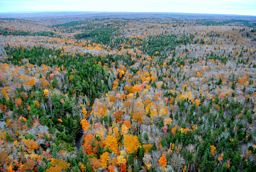 Tracadie River Wilderness Area protects rich upland woodlands at the watershed divide between Chedabucto Bay and Northumberland Strait.
Tracadie River Wilderness Area protects rich upland woodlands at the watershed divide between Chedabucto Bay and Northumberland Strait.
Rolling hills support extensive, mature to old-growth sugar maple and yellow birch forest. Some of this forest is thought to have originated following a massive wind storm in the early 1800s. On flatter ground, these forests are interspersed with pockets of red and black spruce, fir, and white pine. Proportionately, few of Nova Scotia’s wilderness areas have as much old forest. Good soils also make this one of our more biologically productive protected areas.
Part of the wilderness area lies in the North Intervale watershed and drains south to Chedabucto Bay. Another part, along upper Tracadie River, drains north to the Northumberland Strait. The narrow valley carved out by here by Tracadie River provides a natural travel corridor for wildlife between the plateau and lowlands. Small numbers of Atlantic salmon still migrate up the river each year to spawn.
Tracadie River Wilderness Area contains five small freshwater lakes and several bogs of various sizes. It provides habitat for provincially endangered mainland moose and improves representation of the Mulgrave Hills natural landscape in the provincial protected area network.
The area is used for walking, hunting, sportfishing, trapping and other recreation. Parts are suitable for cross country skiing.
North Intervale Road cuts through the wilderness area, providing some vehicle access to the wilderness area. About 4 km of an off-highway vehicle (OHV) trail between North Intervale and Highway 16, near Silvery Brook, is within the wilderness area. This section of trail is managed by the Snowmobilers Association of Nova Scotia (SANS) under an agreement with Nova Scotia Environment.

